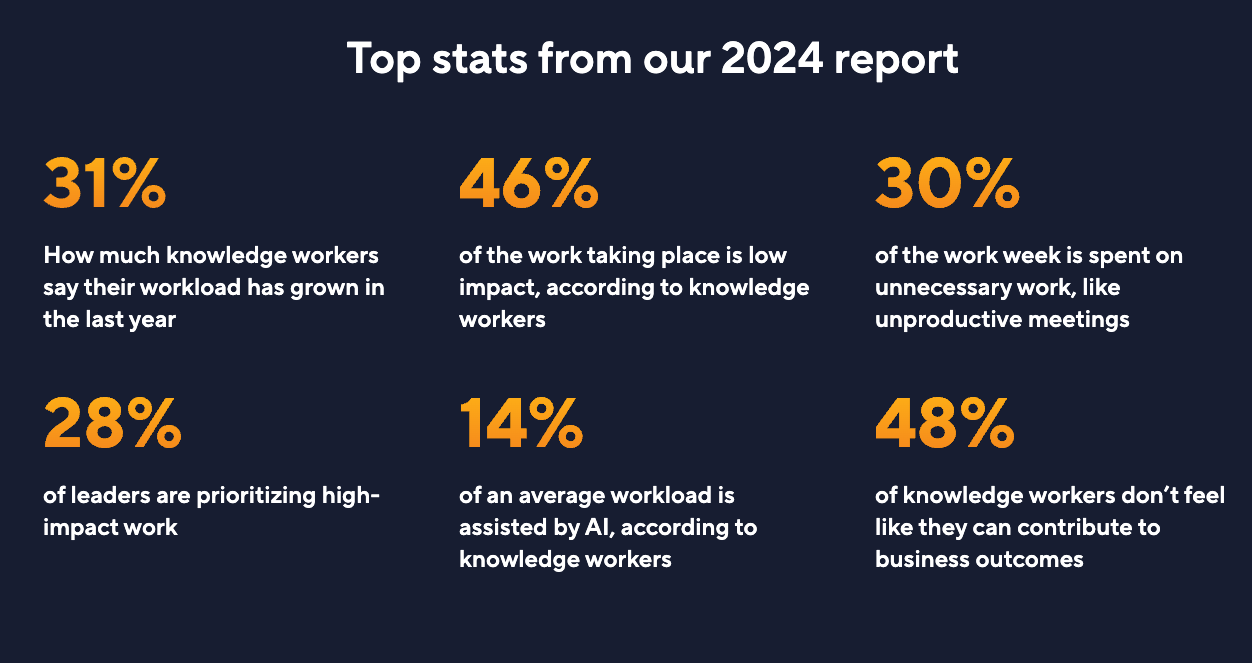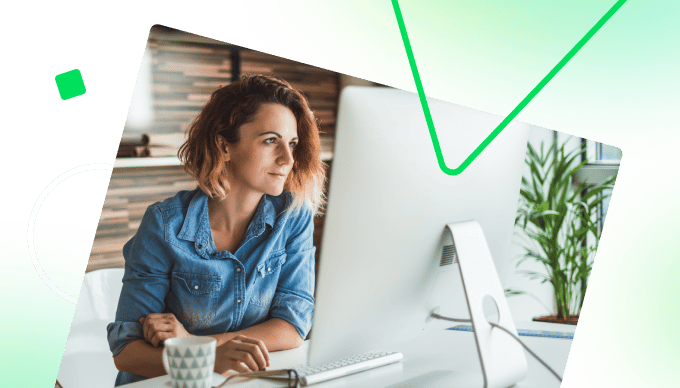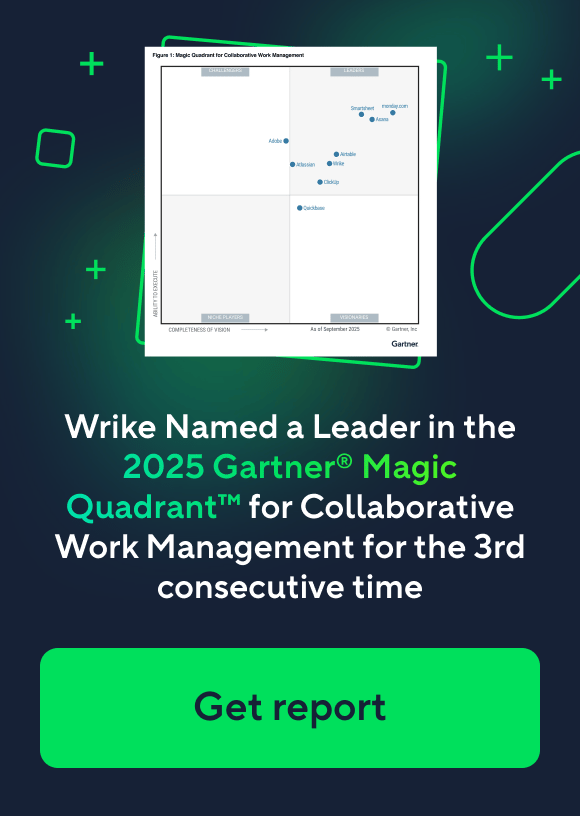Key takeaways:
- What is impactful work? Impactful work contributes to business strategy and growth, moving beyond tedious tasks for meaningful outcomes for both employees and companies.
- What are the barriers to impactful work? Increased workloads, misalignment between leaders and teams, and lack of recognition hinder the focus on high-impact tasks, resulting in inefficiencies.
- How has AI influenced work effectiveness? While AI is seen as beneficial, knowledge workers feel its assistance is limited, with only 14% of their tasks aided by technology, despite leaders’ optimism.
- What shifts are needed for better productivity? Organizations should embrace the mantra “Do less, achieve more” by eliminating unnecessary tasks, consolidating tools, and automating repetitive processes.
- What key actions can drive change? Focus on the PAO framework for meetings, utilize automation for routine tasks, and unify software platforms to enhance clarity and productivity.
Remember when we all tried to do more with less and ended up burning out?
Though it was a noble endeavor — and necessary, in many cases, as employees across the globe struggled with increased workloads in the face of mass layoffs — it led to confused priorities. We thought “more” automatically meant “good,” even if the added tasks didn’t lead to added value.
That’s why this year is all about impactful work. Our new motto (and the tagline of our upcoming Collaborate conference) is do less, achieve more. Organizations that focus on impactful work are better positioned to build thriving workplaces. We’ve seen how a connected, automated workspace helps teams stay on top of real deadlines and data, rather than letting cluttered inboxes run the day. That’s exactly what Wrike brings to the table.
On that note, we recently commissioned a report with Sapio Research to assess the current state of the workplace. We surveyed 1,000 business leaders and 2,500 knowledge workers across the U.S., U.K., DACH, France, and Japan to get accurate insights into the most pervasive issues and their consequences.
The resulting data painted a vivid picture of today’s landscape, which equipped us with the intel needed to create a “what to do now” guide for organizations that want to transform their workplace culture. In other words, if you tried to do more with less and need something a bit more sustainable, this is for you.
We present the 2024 Impactful Work Report.

What is impactful work?
In a nutshell, impactful work is work that contributes to the strategy, growth, and revenue of a business. It’s the opposite of that mind-numbing admin we’ve all had to do, like manually updating a spreadsheet each time a date changes or clearing out old tasks in your workspace.
Though there may be some tasks you personally like doing and even small gestures that can create a positive working environment, these activities are not the same as high-impact work. One of our survey respondents put it best:
“I define impactful work as productive work that’ll benefit both the person doing the work and the corporation responsible for assigning the work.”
Think of it as the best of both worlds. Truly impactful work will have tangible value for an employer — be that reaching a particular milestone in the overall strategy, hitting a growth target in a specific department, or increasing the company’s yearly profits — while making the employee feel valued in their role, knowing their work is recognized and has a direct result on success.
At Wrike, we often talk about workflows that have a direct influence on bigger goals. When team members see how each task connects to strategic outcomes, they realize they’re delivering truly impactful work that drives organizational growth and personal fulfillment.
Barriers to impactful work
Unfortunately, identifying impactful work is not the hard part. Our report found that although business leaders and knowledge workers know exactly what high-impact work looks like, both groups believe that just over half of their workload falls into that category. Shockingly, only 28% of business leaders are prioritizing high-impact work.
There are a number of factors at play that can hamper strategic efforts, and one of these is increased workloads. Workers say their workload has grown by 31% in the last year, while leaders say the figure is 46% for their department/team.
Despite the help offered by AI, it’s clear it’s not the silver bullet it was made out to be. There is a large discrepancy between managers and their teams on how useful the technology actually is. Knowledge workers believe only 14% of their role is assisted by AI, while their managers think it’s more than double that (32%). However, those who do use AI have noted the benefits, as 51% of workers say the technology has somewhat or significantly improved their ability to do their job, with 80% of leaders in agreement.

On top of the mounting workloads and lack of alignment with leadership, there’s also a growing sense of employee unhappiness. Almost half of knowledge workers don’t feel like their work is recognized and they spend an average of 40.8 hours of their own time each year making up for wasted time at work. These are issues that eat away at motivation and erode any sense of belonging, prompting employees to jump ship and find meaning elsewhere.
Business leaders aren’t happy either, as these inefficiencies are impacting the bottom line. Nearly 1.5 days a week are spent on unnecessary work, meaning organizations are wasting a massive $15,138.03 per employee per year.
We’ve seen these barriers grow when workflows aren’t unified. Unclear ownership and tasks siloed across different tools can turn a high-impact goal into a messy process. Eliminating these friction points helps restore clarity and re-energize teams to focus on the most meaningful tasks.

How to make an impact
Many of us have been working on autopilot, adopting a “power through it” mentality to cope with the influx of inbox requests. We’ve been accepting our extra tasks without stopping to think (or ask) if they really contribute any value to the business. While it may have sustained us through some busy periods, it’s clear now that we need a better solution.
We’ve mentioned that “Do less, achieve more” is the new rallying cry for organizations that want to cut out the dark matter of work and stay hyperfocused on efficiency measures that don’t just involve stripping resources from employees and expecting them to deliver more.
Shifting toward impact-based workflows means going beyond just checking off tasks. The real question is, “Which steps genuinely move the needle?” By cutting out wasted efforts, you can tighten up your processes and preserve mental bandwidth for the parts of your job that boost morale — and revenue.
Our report offers a lot of varied tips on how to put this mantra into practice, but here are three for now: eliminate, consolidate, automate.
- Eliminate: Could this meeting have been an email? We joke about this a lot, but seriously — could it have been an email? At Wrike, we follow the PAO (Purpose, Agenda, Outcomes) framework; if a scheduled meeting doesn’t have a clear purpose, agenda, and desired outcomes listed in the invite, feel free to decline it.
- Automate: Though AI can’t replace you or the valuable things you do, it can help you keep things ticking over in the background. Use automation to create new tasks, change task statuses, tag assignees — anything that needs to be done regularly but doesn’t require a human touch.
- Consolidate: We offer all-in-one work management software so we may be a little biased here, but there’s no denying the benefits of ditching seldom-used tools in favor of one unified workspace. In fact, our research showed that consolidating software apps has saved knowledge workers an average of four hours per week, and almost three-quarters (72%) say it’s helped them see how their work impacts company goals.

Of course, this is not the full story. To fully dive into our latest research, download Wrike’s 2024 Impactful Work Report today. (Did we forget to mention the best part? It’s totally free.)





